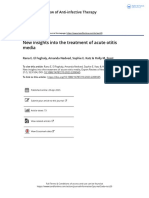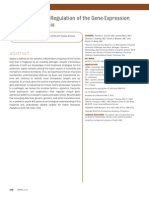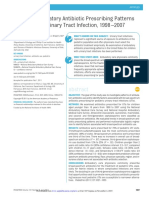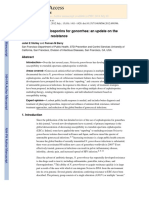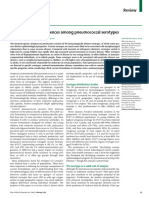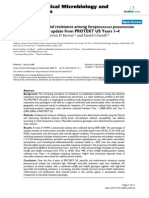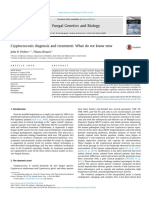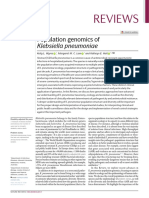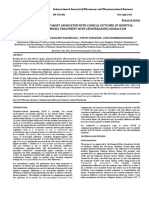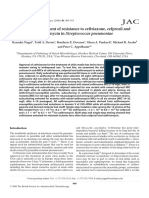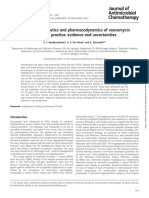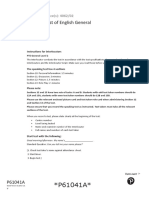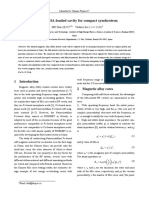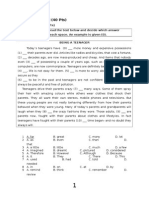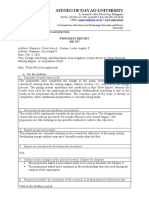Differences Between Ceftriaxone and Cefotaxime Microbiological Inconsistencies
Differences Between Ceftriaxone and Cefotaxime Microbiological Inconsistencies
Uploaded by
Irsan Fahmi ACopyright:
Available Formats
Differences Between Ceftriaxone and Cefotaxime Microbiological Inconsistencies
Differences Between Ceftriaxone and Cefotaxime Microbiological Inconsistencies
Uploaded by
Irsan Fahmi AOriginal Description:
Copyright
Available Formats
Share this document
Did you find this document useful?
Is this content inappropriate?
Copyright:
Available Formats
Differences Between Ceftriaxone and Cefotaxime Microbiological Inconsistencies
Differences Between Ceftriaxone and Cefotaxime Microbiological Inconsistencies
Uploaded by
Irsan Fahmi ACopyright:
Available Formats
ARTICLES
Infectious Diseases
Differences Between Ceftriaxone and Cefotaxime:
Microbiological Inconsistencies
John G Gums, D Wesston Boatwright, Mark Camblin, Diane C Halstead, Mark E Jones, and Roger Sanderson
he past decade has seen increasing
T resistance rates among clinical iso-
lates of Streptococcus pneumoniae in the
OBJECTIVE: To review data to determine why pneumococcal isolates appear to be
increasingly resistant to cefotaxime, historically regarded as having the same in
US, specifically to penicillin and ery- vitro susceptibility to ceftriaxone, and what this observation might imply clinically.
thromycin.1 The percentage of isolates DATA SOURCES: Literature was accessed through MEDLINE (1966–October
causing nonmeningeal syndromes non- 2007) using the MeSH terms cefotaxime, ceftriaxone, susceptibility, microbial
sensitivity tests, antibiotics, pneumococcal infections, Streptococcus pneumoniae,
susceptible to penicillin ranged from
resistance, and cephalosporin resistance. Abstracts and surveillance databases
24.3% in 1998 to 26.5% in 2000 and was were reviewed and unpublished data were provided by state departments of health
consistently higher among isolates causing and institutions.
meningitis.2 Emergence of this resistance STUDY SELECTION AND DATA EXTRACTION: All articles published in the English
has been linked to development of pneu- language that were identified from the data sources were evaluated.
mococcal strains with mosaic penicillin- DATA SYNTHESIS: An experimental model of pneumococcal infection in mice
binding proteins, 6 of which have been conducted 2 decades ago predicted that the delta T minimum inhibitory concen-
identified in S. pneumoniae.3 tration (MIC) varied less for ceftriaxone than for cefotaxime. Studies of plasma and
serum concentrations show that ceftriaxone remains at a concentration above the S.
Ceftriaxone and cefotaxime are extend-
pneumoniae MIC for 100% of the dosing interval at 12 hours. Types of MIC
ed-spectrum third-generation cephalo- susceptibility test methods for ceftriaxone and cefotaxime used against S.
sporin β-lactam antimicrobial agents that pneumoniae respiratory isolates were found to be similar. Data from state and
historically have possessed similar in vitro county health departments found microbiological discrepancies between ceftriaxone
susceptibility for S. pneumoniae.4 In 2003, and cefotaxime. In areas with high rates of penicillin-resistant S. pneumoniae
the National Committee for Clinical Labo- (PRSP), isolates were twice as susceptible to ceftriaxone versus cefotaxime.
Surveillance databases consistently show differences between susceptibility of S.
ratory Standards (NCCLS; now the Clini-
pneumoniae to cefotaxime versus ceftriaxone over time. MIC and pulsed-field gel
cal and Laboratory Standards Institute electrophoresis studies suggest that phenotypic discrepancies may account for
[CLSI]) M100-S13 guideline Table 1A penicillin resistance. Ongoing studies are examining S. pneumoniae isolates at the
(minimum inhibitory concentration [MIC] molecular level to determine the basis of difference in resistance to cefotaxime
testing) stated that either ceftriaxone or and ceftriaxone.
cefotaxime could be tested against S. CONCLUSIONS: An increase in rates of PRSP and differences in S. pneumoniae
pneumoniae.5 Strains of S. pneumoniae isolate susceptibility between ceftriaxone and cefotaxime emphasize the necessity
for hospital laboratories to detect these changes as they occur. Clinicians should
susceptible to or having intermediate resis-
select the most appropriate agent for patients with S. pneumoniae.
tance to penicillin were usually also sus-
KEY WORDS: cefotaxime, ceftriaxone, Streptococcus pneumoniae.
ceptible in vitro to ceftriaxone and cefo-
Ann Pharmacother 2008;42:71-9.
taxime.6 As outlined by the then-NCCLS
recommendations, most clinical laborato- Published Online, 19 Dec 2007, www.theannals.com, DOI 10.1345/aph.1H620
THIS ARTICLE IS APPROVED FOR CONTINUING EDUCATION CREDIT
ACPE UNIVERSAL PROGRAM NUMBER: 407-000-08-001-H01
Author information provided at the end of the
text.
www.theannals.com The Annals of Pharmacotherapy n 2008 January, Volume 42 n 71
Downloaded from aop.sagepub.com at UQ Library on June 2, 2014
JG Gums et al.
ries tested against one agent in the class and extrapolated ceftriaxone, susceptibility, microbial sensitivity tests, an-
MIC interpretations of susceptible, intermediate, or resistant tibiotics, pneumococcal infections, Streptococcus pneumo-
to other drugs in the same class. MIC interpretations were niae, resistance, and cephalosporin resistance. Abstracts
rarely reported together for similar agents within the same and surveillance databases were received and unpublished
class. data were provided by the authors, state departments of
However, in March 2001, at a hospital laboratory in health, and institutions.
Florida, adjacent comparison of local surveillance docu-
ments noted that ceftriaxone and cefotaxime susceptibili- Study Selection and Data Extraction
ties to S. pneumoniae displayed a 20% discrepancy, with
the isolates significantly more susceptible to ceftriaxone. All articles published in English identified from the data
Subsequent observations within the State Departments of sources were evaluated.
Health of Florida and Oklahoma found similar discrepan-
cies. Further investigation in the fall of 2001, using data Data Synthesis
from the Antimicrobial Resistance Management (ARM)
program (www.armprogram.com), demonstrated a nation- To delineate why the observed differences in S. pneu-
al susceptibility difference of 80.4%a for ceftriaxone versus moniae isolate susceptibility discrepancy between ceftriax-
69.2% for cefotaxime.7,a This report was the first publica- one and cefotaxime might be occurring, we reviewed data
tion from a surveillance system to note a significant differ- from a number of different sources (Table 1). Both broth
ence between these 2 agents. At that time, the ARM pro- microdilution and pulsed-field gel electrophoresis (PFGE)
gram contained approximately 10 million isolates in aggre- test methods have identified phenotypic differences among
gate containing 21,127 isolates of S. pneumoniae. A clinical S. pneumoniae isolates.
retrospective review of these data suggests that a separa- In January 2002, the then-NCCLS published new MIC
tion between the 2 drugs began to occur when the cefo- interpretative breakpoints for meningeal and nonmeningeal
taxime dosing interval apparently was changed from every S. pneumoniae isolates that increased the nonmeningeal
8 hours to every 12 hours in 1995 in various hospitals in pneumococcal susceptibility breakpoints for cefotaxime and
the Southeast, a short-lived phenomenon not recommend- ceftriaxone.9 The intermediate breakpoint for nonmeningeal
ed by the then-NCCLS.8 Figure 1 shows national trends for isolates was 2.0 µg/mL and the resistant breakpoint was
ceftriaxone and cefotaxime from 1995 to 2003. greater than or equal to 4.0 µg/mL. For meningeal isolates,
In this article, we detail results of investigations that the breakpoints remain unchanged (1.0 µg/mL for intermedi-
have consistently documented the initial observation of the ate, ≥2.0 µg/mL for resistant). The data represented in this re-
S. pneumoniae isolate susceptibility discrepancy between port show susceptibilities observed through various years.
ceftriaxone and cefotaxime. Before the 2002 changes to Data prior to 2002 may reflect old breakpoints and thus arti-
the current breakpoints, these antibiotics were treated like ficially suppress susceptibility; reports from 2002 and later
penicillin, with one breakpoint, regardless of where the years should not be directly compared with reports from
isolate originated. With the change, breakpoints for non- previous years that used old breakpoints unless they have
meningeal sources of S. pneumoniae were increased (eg, to been corrected. Current breakpoints at 1.0 µg/mL, 2.0
2 µg/mL for intermediate, and ≥4 µg/mL for resistant iso- µg/mL, and 4.0 µg/mL for nonmeningeal isolates for cef-
lates), while those for meningeal sources remained the triaxone nationally have been reported at greater than or
same. Had the penicillin breakpoints originally differentiat- equal to 96% susceptibility in various surveillance reports.6
ed between meningeal and nonmeningeal sources, it re-
mains to be seen whether the level of resistance to the Susceptibility Testing Methods
third-generation cephalosporins cefotaxime and ceftriax-
one would have arisen and, if so, had this difference been In a study conducted to determine what types of MIC test
more specifically addressed, whether the current discrep- methods for ceftriaxone and cefotaxime were used against S.
ancy would have been observed. pneumoniae respiratory isolates, 150 institutions participat-
ing in The Surveillance Network (TSN) Database—USA in
Data Sources 1997–2000 were surveyed (data provided by Dr. Jones).
Two test methods were found to be primarily in use: E-test
Literature was accessed through a MEDLINE search and microdilution MIC method manual. In fact, given that
(1966–October 2007) using the MeSH terms cefotaxime, S. pneumoniae is a fastidious organism, until recently,
many laboratories used only either the Kirby-Bauer or the
E-test. Institutions reported using the E-test for 56.6% of
a
Throughout the article, this footnote indicates that values were obtained using pre-
their S. pneumoniae isolate testing against ceftriaxone and
2002 NCCLS breakpoints. 61.2% against cefotaxime and the microdilution MIC
72 n The Annals of Pharmacotherapy n 2008 January, Volume 42 www.theannals.com
Downloaded from aop.sagepub.com at UQ Library on June 2, 2014
Differences Between Ceftriaxone and Cefotaxime: Microbiological Inconsistencies
method manual for 30% of their tests against ceftriaxone ative bacteria, the unbound drug concentration should ex-
and 26.3% against cefotaxime. These results suggest that ceed the MIC (T>MIC) for at least 40–60% of the dosing
the test methods used were similar and not likely to con- interval.11 For other gram-positive bacteria, the unbound β-
tribute to the susceptibility differences noted between cef- lactam concentration can exceed the MIC for as little as
triaxone and cefotaxime. 25% of the dosing interval for efficacy.11,12 Increases in
Using the same database, quantitative data from non- MIC may affect the pharmacodynamic parameter for an-
meningeal isolates of S. pneumoniae concomitantly tested tibacterials, which can lower efficacy in vivo. However, an
against ceftriaxone and cefotaxime collected from 117 hos- increase in bacterial MICs to antibacterials with an effica-
pitals in 33 states from 2000 to 2002 were analyzed using cy parameter dependent on T>MIC (eg, cephalosporins)
pre-2002 NCCLS breakpoints to determine whether differ- does not always result in a proportional reduction in the
ences in susceptibility by state and/or by test method exist- pharmacokinetic/pharmacodynamic parameter unless the
ed.10 Three test methods were used to test the majority of increase in MIC is severe enough to intersect the break-
the isolates: MicroScan MICro Strep panel (33.4%), E-test point. Small increases in MIC are least likely to signifi-
strips (19.2%), and Vitek 2 (21.3%). The nonmeningeal S. cantly impact drugs with a long elimination half-life, such
pneumoniae isolates were found to be consistently more as ceftriaxone (5.8–8.7 h), because T>MIC is preserved.
susceptible to ceftriaxone than to cefotaxime, regardless of This would not apply to cefotaxime due to its short half-
year or test method, leading the investigators to suggest life (~1 h), which imparts more dramatic concentration
that the differences were not artifactual. Among all isolates peaks and troughs, increasing the likelihood that drug con-
tested, ceftriaxone susceptibility was noted to be 2.3% centration dips below the MIC.12 Thus, the magnitude of
higher than that of cefotaxime, a difference that was geo- change in MIC (known as “MIC creep”) can prevent target
graphically widespread. In 10 of 16 states, greater than antibiotic exposure from being attained. In fact, an experi-
2.5% higher susceptibility rates for ceftriaxone were found mental model of pneumococcal infection in mice conduct-
for at least 1 of the 3 years; in Washington, DC (which ed in 1987 predicted that the delta T MIC varied less for
used only MicroScan MICro Strep) and Louisiana (which ceftriaxone than for cefotaxime.13 Susceptibility changes
used only E-test), this difference in susceptibility was not- for drugs that have long half-lives, and efficacy dependent
ed for all 3 years (range 2.7–17%). on T>MIC may not affect the percentage of patients who
achieve target exposures. Current methods for breakpoint
Pharmacokinetic/Pharmacodynamic Observations determination do not consider this interpatient variability.12
Initial research conducted to determine the effect of
The in vitro antibacterial effects of β-lactams are due to MIC breakpoint changes on category interpretation for S.
a time-dependent killing mechanism. For maximal β-lac- pneumoniae respiratory isolates from 1997 to 2000 found
tam antibacterial activity to Pneumococcus and gram-neg- subtle differences between cefotaxime and ceftriaxone for
Table 1. Areas of Data Synthesis
Susceptibility testing methods Surveillance databases
Pharmacokinetic/pharmacodynamic observations Minimum inhibitory concentration and
Department of Health data pulsed-field gel electrophoresis studies
Institutional data
Figure 1. National trends for Streptococcus pneumoniae susceptibility in the Antimicrobial Resistance Management Program, 1995–2003.
www.theannals.com The Annals of Pharmacotherapy n 2008 January, Volume 42 n 73
Downloaded from aop.sagepub.com at UQ Library on June 2, 2014
JG Gums et al.
both the then-current (≤0.5, 1, ≥2 µg/mL) and proposed susceptibility data included erythromycin 36.8%, clin-
(now current 1, 2, ≥4 µg/mL) breakpoints, with isolates damycin 18.0%, and imipenem 36.1%. Similar trends
more susceptible to ceftriaxone. were seen for Orange and Duval Counties; overall, only 2
In data presented to the NCCLS during discussions of counties in Florida reported similar ceftriaxone and cefo-
the breakpoint changes, one study showed that the popula- taxime susceptibilities.
tion meeting the efficacy target of T>MIC equal to at least A surveillance study of S. pneumoniae susceptibility to
50% of the dosing interval at an MIC of 1.0 µg/mL was ceftriaxone and cefotaxime from the Florida Department
99.3% for ceftriaxone 1 g every 24 hours and 37.3% for of Health for 2000 found that, as measured by percentage
cefotaxime 1 g every 12 hours.14 At an MIC of 2.0 µg/mL, of isolates categorized as intermediate or resistant, 21.6%a
the rate was 73.1% for ceftriaxone and 16.2% for cefo- were nonsusceptible to ceftriaxone and 32.8%a were non-
taxime. When the study was repeated with cefotaxime 1 g susceptible to cefotaxime (Table 2). Most (90%) of the iso-
every 8 hours, 88.2% of patients met the MIC less than or lates were from blood. The infection type was reported for
equal to 50% efficacy target at 1.0 µg/mL and 65.6% of 65% of cases. Of these 1051 cases, bacteremia (n = 503)
patients at 2.0 µg/mL. was the most common (47.9%); pneumonia (n = 369) rep-
Studies of plasma and serum concentrations of the 2 resented 35.1%, meningitis (n = 122) 11.6%, otitis media
agents show that a single intravenous dose of ceftriaxone 1 (n = 31) 2.9%, and other (n = 26) 2.5%. Nearly 40% of the
g produces a 24-hour plasma trough concentration of 9.3 cases were children 5 years of age or younger, and 23%
µg/mL, whereas a single intravenous dose of cefotaxime 1 were adults aged 55 years or older.18 A comparison of spe-
g has an 8-hour serum trough concentration limit that is cific counties representing the major metropolitan areas in
below detection (0.3 µg/mL).15 A 24-hour study of un- Florida showed nonsusceptibility rates to be consistent
bound concentrations (pleural exudate) of ceftriaxone dis- with observations from the state as a whole, with the high-
played a concentration of 4.4 µg/mL at 50% of the dosing
interval at 12 hours. Therefore, the concentration was
above the S. pneumoniae MIC of 1.0 µg/mL for 100% of
the dosing interval (2.0 µg/mL at 24 h).16 Table 2. Streptococcus pneumoniae Clinical Isolate
Susceptibility to Ceftriaxone and Cefotaxime in
Additionally, from 1996 to 2000, ceftriaxone not only re-
Florida, 2000a,b
mained the most potent β-lactam agent studied against com-
mon gram-positive clinical isolates in the TSN Database— Ceftriaxone Cefotaxime
USA, but had the most consistent in vitro activity, demon- Location % Isolates (n) % Isolates (n)
strating stability over time: resistance was 6.3%a in 1996 State
and 5.4%a in 2000.17 Florida S 78.4 1130 67.2 1065
I 16.3 22.9
The influence of the active metabolite of cefotaxime, R 5.3 9.9
desacetylcefotaxime, was not factored into the overall ac-
County
tivity of the assessment of cefotaxime’s activity—or lack Orange S 93.3 112 82.2 134
of activity—against S. pneumoniae. Furthermore, if no in- I 1.7 13.4
formation was provided stating whether figures for ceftri- R 5.0 3.7
Dade–Miami S 82.8 163 64.9 154
axone had been corrected for protein binding, we assumed
I 12.3 20.1
them to be reported uncorrected. R 4.9 14.9
Duval S 82.4 51 64.4 73
Department of Health Data I 13.7 20.5
R 3.9 15.1
Data from Florida state and county health departments Broward S 81.5 146 76.9 26
I 15.8 19.2
demonstrated similar trends in pneumococcal susceptibili-
R 2.7 3.8
ty for ceftriaxone and cefotaxime and support the hypothe- Hillsborough S 67.2 45 53.6 67
sis that microbiological discrepancies between these 2 I 23.9 36.8
drugs exist. Furthermore, these findings show that isolates R 9.0 9.6
that are twice as susceptible to ceftriaxone compared with Palm Beach S 76.4 110 70.7 92
I 16.4 19.6
cefotaxime consistently occur in areas with high rates of R 7.3 9.8
penicillin-resistant S. pneumoniae (PRSP). In Florida, Pinellas S 72.6 62 52.7 55
which has S. pneumoniae on its reportable diseases list, I 17.7 25.5
penicillin nonsusceptibility rates were 56.5% in 2000 and R 9.7 21.8
48.9% in 2001. For Dade–Miami County alone in 2000, I = intermidiate; R = resistant; S = susceptible.
a
PRSP susceptibility was 64.5%; nonsusceptibility to ceftri- Based on pre-2002 changes in breakpoints.
b
Some percentages do not equal 100% due to rounding.
axone was 17.2%a and to cefotaxime, 35.0%.a Other non-
74 n The Annals of Pharmacotherapy n 2008 January, Volume 42 www.theannals.com
Downloaded from aop.sagepub.com at UQ Library on June 2, 2014
Differences Between Ceftriaxone and Cefotaxime: Microbiological Inconsistencies
est percentage nonsusceptibility discrepancies to cefo- namic data which show that cefotaxime use may result in
taxime. cefotaxime resistance, especially with twice daily dosing,
Data from other regions suggest that the discrepancy in because cefotaxime is used more in the pediatric popula-
susceptibility rates for ceftriaxone and cefotaxime may be tion due to ceftriaxone being contraindicated in infants due
more prevalent in the southern US states. In Wisconsin in not only to the potential risk for hepatobiliary sludging, but
2002, for example, of 352 pneumococcal isolates reported also from bilirubin displacement associated with the high
(334 were nonmeningeal), 96.7% were susceptible to cefo- protein binding of ceftriaxone.
taxime and 98.8% to ceftriaxone, using the 2003 NCCLS In Oklahoma, a city hospital with a reported 67% preva-
breakpoints.19 lence of penicillin-nonsusceptible S. pneumoniae isolates
tested 48 isolates during a 5-month period in 1997 and
Institutional Data 1998 for antibiotic susceptibility and repeat-tested the
same isolates at 2 other hospital laboratories (Hospitals A
Several institutions have conducted studies to confirm and B).21 Of the 48 isolates, Hospital A found 31 (65%) to
anecdotal reports of the susceptibility differences between be penicillin-nonsusceptible S. pneumoniae and 23 (48%) to
ceftriaxone and cefotaxime for S. pneumoniae isolates. In be highly penicillin resistant; Hospital B showed a similar
Tennessee, a hospital analyzed S. pneumoniae isolates by (62%) prevalence, although fewer (29%) isolates were highly
E-test from 2000 to 2001 and found 58% to be susceptible resistant. Both hospitals used the E-test to evaluate suscepti-
to penicillin, 78% to cefotaxime, and 90% to ceftriaxone. bility to third-generation cephalosporins, with Hospital A us-
Among PRSP isolates alone, nonsusceptibility to ceftriax- ing cefotaxime as the test antibiotic and Hospital B, ceftriax-
one was 58% and to cefotaxime, 92% (data provided by one. Hospital A reported 13 (27%) isolates to be resistant to
Dr. Camblin). cefotaxime, compared with 4 (8%) isolates resistant to ceftri-
A community medical center in central Florida conduct- axone at Hospital B. The authors concluded that if con-
ed an E-test of S. pneumoniae isolates from July 2001 to firmed, this finding would have relevance in clinical settings
June 2002 using the new NCCLS breakpoints. Of the iso- where one antibiotic is used to test for susceptibility and the
lates, 40% were PRSP. Nonsusceptibility to ceftriaxone other for treatment, given that S. pneumoniae may not have
was 8% and, to cefotaxime, 25%. Similarly, an academic equal susceptibility to both agents.
medical center in northeastern Florida conducted an E-test
of S. pneumoniae isolates using the new NCCLS break- Surveillance Databases
points and found 4% to be nonsusceptible to ceftriaxone
versus 26% to cefotaxime (personal communication, Noel Reports from several surveillance databases such as the
Gomez, Supervisor, Clinical Microbiology Laboratory, ARM Program, SENTRY Europe, and TSN Database—
SHANDS Jacksonville, Jacksonville, FL, November 1, USA have documented and/or observed a trend in the di-
2006). An academic medical center in Alabama tested 118 vergence in susceptibility to S. pneumoniae isolates be-
isolates from 2001 using E-test and found a greater per- tween ceftriaxone and cefotaxime.
centage of isolates to be susceptible to ceftriaxone (94.9%) Established in 1997, the ARM program includes a na-
than to cefotaxime (84.7%) (personal communication, Ken tional surveillance database that currently includes more
Waites MD, Professor, Departments of Pathology, Micro- than 30 million isolates of 19 organisms and 48 antibiotics.
biology, Physical Medicine and Rehabilitation, Diagnostic In the program’s initial report in 2001, PRSP was 37.5%
and Critical Care, University of Alabama, Birmingham, among all isolates in the database.7 Nationally, differences
School of Medicine, Birmingham, AL, November 1, were noted between susceptibility of S. pneumoniae to cef-
2006). otaxime (69.2%a) and ceftriaxone (80.4%a). For both
A study of S. pneumoniae resistance trends
conducted among a consortium of hospitals in
north Florida from 1995 to 2001 found that
susceptibility to penicillin decreased from 70% Table 3. Nonsusceptible Streptococcus pneumoniae Isolates in the
to 49% and susceptibility to cefotaxime de- North Florida Pediatric Population, 1996–2003
creased from 83% to 75%, while susceptibility Nonsusceptible, %
to ceftriaxone increased from 81% to 93% Antibiotic 1996 1997 1998 1999 2000 2001 2002 2003
(pre-2002 NCCLS breakpoints).20 A separate Penicillin 49 58 66 63 75 68 63 64
analysis found that the most dramatic differ- Cefotaxime 45 36 46 37 47 61 52/25a 30/16a
Ceftriaxone 20 14 33 25 32 42 36/9a 17/13a
ence between cefotaxime and ceftriaxone oc-
curred in the pediatric population (data provid- CSF = cerebral spinal fluid.
a
ed by Dr. Halstead) (Table 3). This finding New National Csommittee on Clinical Laboratory Standards 2002 Streptococcus
pneumoniae CSF/non-CSF breakpoints.
supports pharmacokinetic and pharmacody-
www.theannals.com The Annals of Pharmacotherapy n 2008 January, Volume 42 n 75
Downloaded from aop.sagepub.com at UQ Library on June 2, 2014
JG Gums et al.
drugs, susceptibility rates were higher in the Northeast by region using both methods, PRSP isolates were more
(89.6%a for cefotaxime and 90.5%a for ceftriaxone) and susceptible to ceftriaxone than to cefotaxime by the widest
lower in the Southeast (61.8%a for cefotaxime and 77.8%a margin in the South. For broth microdilution, 92% of the
for ceftriaxone). PRSP isolates were susceptible to ceftriaxone versus 79%
In 2002, a follow-up report detected a consistent differ- for cefotaxime; by E-test method, these results were 91%
ence nationally for each year analyzed from 1995 to 2001, for ceftriaxone and 75% for cefotaxime. The smallest mar-
with resistance rates higher for cefotaxime than for ceftri- gin occurred in the West: by broth microdilution, 87% of
axone.8 This discrepancy was attributed primarily to iso- PRSP isolates were susceptible to both antimicrobial
lates collected in the Southeast, which showed an overall agents; by E-test method, susceptibility was 84% for ceftri-
susceptibility of 65%a to cefotaxime and 77.7%a to ceftri- axone and 82% for cefotaxime.
axone. The aggregate sensitivity numbers for both cefo- Of the 1000 S. pneumoniae isolates tested, 666 were
taxime and ceftriaxone were calculated using NCCLS found to be penicillin susceptible, 146 penicillin intermedi-
breakpoints in place prior to January 2002. ate, and 188 PRSP.10 Of the 188 PRSP isolates, 26 (13.8%)
For 1995–2002, a national susceptibility to ceftriaxone displayed phenotype discrepancies by MIC interpretation.
and cefotaxime was found to be similar to that previously By broth microdilution, 18 were ceftriaxone susceptible
reported for S. pneumoniae (ie, 83.2% for ceftriaxone, and cefotaxime intermediate, 6 were ceftriaxone interme-
74.5% for cefotaxime), with the greatest difference ob- diate and cefotaxime resistant, and 2 were ceftriaxone sus-
served in the Southeast (81.4% for ceftriaxone, 69.6% for ceptible and cefotaxime resistant. The majority (65%)
cefotaxime).22 were from the southern US states (Alabama, Florida, Ten-
SENTRY data from 1997 to 2000 in Europe reported nessee, Louisiana, Oklahoma, Georgia).
PRSP rates ranging from 24.5% to 41.3%; cefotaxime re- Among the 26 isolates with different MIC interpretative
sistance was 0.9–7.5% at MIC 90% at 1 µg/mL from 1997 phenotypes, 5 serogroups and serotypes (6, 9, 14, 19, 23)
to 1999, while ceftriaxone resistance was 4.8% for 2000.23 were found that are commonly associated with penicillin-
resistant isolates.3 A SmaI PFGE to serotype, the non-
MIC and PFGE Studies meningeal S. pneumoniae isolates identified in the MIC
study found 8 isolates not related to any of the others. The
Six pneumococcal strains with mosaic penicillin-bind- differences between the 2 agents in these studies were due
ing proteins (PBPs) have been identified in S. pneumoniae. solely to their activities against penicillin-resistant isolates,
Five are high-molecular-mass PBPs (80–90 kDa; PBP 1A, with both broth microdilution and E-test methods confirm-
1B, 2A, 2B, and 2X) and one is a low-molecular-mass ing a greater than 10% higher susceptibility to ceftriaxone
PBP (45 kDa; PBP 3). The primary targets of penicillin are than to cefotaxime in PRSP isolates. Discrepant isolates
the PBPs 2X and 2B, with high-level resistance to peni- were more often associated with a clonal PFGE type or
cillin occurring via alterations of the PBPs 2X, 2B, and subtype and serotype when compared with the control iso-
1A, among other mechanisms.3,24,25 Changes within PBP lates.
1A and 2X cause resistance in pneumococci to extended- Three recent studies in children have identified increas-
spectrum cephalosporins. ing resistance among penicillin-resistant pneumococcal
An MIC study of 1000 isolates was conducted to con- isolates linked to specific serotypes. In Taiwan in 2005, ap-
firm the existence of a divergence between S. pneumoniae proximately 90% of ceftriaxone-nonsusceptible isolates
isolate susceptibility to ceftriaxone and cefotaxime and to were found to be serotypes 6B, 14, 19F, and 23F.26 The au-
rule out differences that might occur due to different test- thors noted that while some reports have indicated that
ing methods.10 Isolates collected from 18 states in the PBP 2B is not a target for extended-spectrum cephalo-
South (Alabama, Florida, Georgia, Louisiana, Oklahoma, sporins and therefore does not necessarily correlate with
Tennessee), Northeast (Massachusetts, New York, New penicillin resistance, they found that altered PBP 2B was
Jersey, Pennsylvania), West (Arizona, California, Wash- involved in the development of ceftriaxone nonsusceptibil-
ington, Utah), and Central (Iowa, Illinois, Minnesota, Wis- ity in pneumococci, with 7 amino acid alterations in the
consin) US regions from October 2001 to May 2002 were transpeptidase-encoding region of PBP 2B specifically
tested against ceftriaxone and cefotaxime. contributing to the resistance. Serotypes 6B, 14, 19F, and
S. pneumoniae isolates were tested side-by-side using 23F are covered by the pneumococcal conjugate vaccine
broth microdilution and E-test methods, and MICs were (not yet in use in Taiwan); nonetheless, Messina et al.27
interpreted using NCCLS 2003 guidelines.10 By broth mi- found invasive pneumococcal disease (IPD) caused by
crodilution method, 92.6% of the PRSP isolates were sus- nonvaccine serotypes to be prevalent among children in
ceptible to ceftriaxone, compared with 81.9% for cefo- Texas, with several highly penicillin-resistant and interme-
taxime; using the E-test method, 91.0% were susceptible diately cefotaxime-resistant strains emerging in 2004 and
to ceftriaxone and 77.7% to cefotaxime. When examined 2005. Serotype 19A was found to have caused 40% of IPD
76 n The Annals of Pharmacotherapy n 2008 January, Volume 42 www.theannals.com
Downloaded from aop.sagepub.com at UQ Library on June 2, 2014
Differences Between Ceftriaxone and Cefotaxime: Microbiological Inconsistencies
cases in 2005. Mason et al.,28 in investigating the cause of The study by Karlowsky et al.10 confirms significant dif-
recurrent systemic pneumococcal disease, found that 7 of ferences in rates of susceptibilities between ceftriaxone
16 children with less than 30 days between infections had and cefotaxime, with certain PRSP isolates less susceptible
acquired a new strain, suggesting that pneumococcal iso- to cefotaxime than to ceftriaxone. The incidence of PRSP
lates be documented to determine whether they have the isolates appears to dictate prevalence, with the South being
same serotype as well as the same PFGE patterns. the regional epicenter. These differences are not dependent
upon the test method used and are clonal in nature. With
Ongoing Phenotyping/Mutagenesis Studies PRSP increasing within certain communities and hospital
settings, it will become increasingly important to select the
Two ongoing studies are examining S. pneumoniae iso- antimicrobial agent most likely to cover the source of the
lates at the molecular level to determine the basis of resis- infection and less likely to select for the discrepant pheno-
tance to the β-lactam antibiotics and to confirm the mutation types. Cefotaxime is anticipated to select further via new
responsible for the discrepancies noted between ceftriaxone clones or by increasing the expansion of existing clones.
and cefotaxime. The first, in which the southern US is better As noted in the Infectious Diseases Society of America
represented, includes 26 pneumococcal isolates from the December 2003 practice guidelines for community-ac-
original 1000 in the MIC/PFGE studies. They are primarily quired pneumonia, S. pneumoniae resistance concerns in
outpatient isolates.29 Initial results found that isolates with dif- North America continue to increase in various antibiotic
ferential ceftriaxone/cefotaxime susceptibility phenotypes are classes.30 The PROTEKT study described in the guidelines
highly clonal; given that they are related to penicillin-resistant reports pockets of nonsusceptibility to levofloxacin to S.
international clones, they have the potential to become pneumoniae ranging from 5.6% to 21.8%.31 Therefore, the
widespread. In addition, within clonal clusters, PBP 1A, 2B, need for local and regional tracking of S. pneumoniae is
and 2X RFLP data showed defined patterns. Strains with di- paramount, as is testing pathogen susceptibilities using the
vergent ceftriaxone and cefotaxime MICs demonstrated antibiotic subsequently prescribed to ensure optimal out-
high-level resistance to both penicillin and amoxicillin. comes in patients with pneumococcal infections. The CDC
The second study, being conducted by the Centers for has recommended that institutions provide treatment based
Disease Control and Prevention (CDC) Active Bacterial on local surveillance data, with antimicrobial susceptibility
Core surveillance program, includes 82 primarily inpatient testing influencing a clinician’s choice of antibiotics.32 De-
PRSP isolates upon which MIC, PFGE, and mutagenesis termining exactly what isolates are being tested and which
studies are being performed. Results will help determine breakpoints are being applied is essential: if susceptibility
whether there is a molecular basis for the difference in cef- breakpoints promote the use of narrower-spectrum antibi-
otaxime and ceftriaxone susceptibilities. otics to treat pneumococcal disease, resistance to broader-
spectrum antibiotics may be slowed.
Discussion The S. pneumoniae susceptibility profile may also affect
healthcare resource utilization. In a 3-year study of 231
Our investigation of resistance trends for ceftriaxone hospitalized patients on the pharmacoeconomic considera-
and cefotaxime has shown that over time, and specifically tions in PRSP, Klepser et al.33 found that 142 patients who
in the southern US, pneumococcal isolates have grown in- had susceptible S. pneumoniae isolates had a 10-day
creasingly resistant to penicillin, leading to nonsusceptibil- length of stay compared with 14 days for 89 patients with
ity rates among PRSP isolates for cefotaxime that are more nonsusceptible isolates. Overall costs were $1600 higher
than twice those for ceftriaxone. A similar divergence is ob- for the patients with the nonsusceptible isolates, 1 in 4 of
served in the Northeast and Central regions of the country, al- whom was admitted to the intensive care unit. Similarly, a
beit occurring more slowly, but not yet in the West. These ap- study on pneumococcal resistance at an urban hospital
parent geographical differences in susceptibility are consis- found that the average length of stay was 10.5 days for pa-
tent with the clonal phenomenon described by the MIC and tients with PRSP versus 5.7 days for those with susceptible
PFGE studies. Clinically, the subtherapeutic concentrations S. pneumoniae isolates.34
that followed every-12-hours dosing with cefotaxime may
have stimulated mutational change within the organism. Summary
Also, differences in susceptibility patterns with an assumed
equivalent breakpoint may have resulted in patients being ex- The increase in rates of PRSP and the differences noted
posed to a less than maximally effective agent (ie, cefo- in S. pneumoniae isolate susceptibility between ceftriaxone
taxime). For example, in some cases, a clinician may have and cefotaxime emphasize the necessity for institutions to
assumed clinical efficacy based on laboratory reports using detect these changes as they occur and to ensure that their
ceftriaxone; however, the hospital pharmacy may have sub- sensitivity reporting systems allow the most appropriate
stituted cefotaxime for ceftriaxone. antimicrobial therapy to be selected for patients with S.
www.theannals.com The Annals of Pharmacotherapy n 2008 January, Volume 42 n 77
Downloaded from aop.sagepub.com at UQ Library on June 2, 2014
JG Gums et al.
pneumoniae. Results of ongoing studies will outline the 7. Gums JG. Antimicrobial susceptibility trends from 1999–2000: prelimi-
nary results of the Antimicrobial Resistance Management (ARM) pro-
patterns of resistance among pneumococcal isolates and gram. Pharmacotherapy 2001;21:1300–1.
further delineate causality and/or mechanistic differences 8. Gums JG. Streptococcus pneumoniae susceptibility from 1995–2001: re-
between these 2 agents. In the meantime, we encourage all sults of the Antimicrobial Resistance Management (ARM) Program.
Presented at: Annual Meeting of the American College of Clinical Phar-
institutions to urge the CLSI to adopt rigorous breakpoints macy, Albuquerque, NM, October 20–23, 2002.
for cefotaxime and ceftriaxone that are based on suscepti- 9. Performance standards for antimicrobial susceptibility testing, 12th in-
bility data derived after 1995. Correlation of breakpoints to formational supplement. NCCLS document M100-S12. Wayne, PA: Na-
tional Committee for Clinical Laboratory Standards, 2002.
clinical outcomes is ideal. In the absence of such data, the
10. Karlowsky JA, Draghi DC, Master RN, Thornsberry C, Jones ME,
CLSI is encouraged to consider that cefotaxime and ceftri- Sahm DF. Some clinical laboratories in the US report higher susceptibili-
axone are not interchangeable and to request institutions ty to ceftriaxone compared to cefotaxime for pneumonia (poster). Pre-
and laboratories to evaluate each of these choices indepen- sented at: 103rd General Meeting of the American Society of Microbiol-
ogy, Washington, DC: May 18–22, 2003.
dently based on local resistance patterns. 11. Dudley MN, Ambrose PG. Pharmacodynamics in the study of drug re-
sistance and establishing in vitro susceptibility breakpoints: ready for
John G Gums PharmD, Professor, Pharmacy and Medicine, Direc- prime time. Current Opin Microbiol 2000;3:515-21.
tor of Clinical Research in Family Medicine, Departments of Pharma- 12. Craig WA. Pharmacokinetic/pharmacodynamic parameters: rationale for
cy Practice and Family Medicine, University of Florida, Gainesville, FL antibacterial dosing of mice and men. Clin Infect Dis 1998;26:1-12.
D Wesston Boatwright PharmD, Senior Medical Liaison, Medi- 13. Frimodt-Moller N, Bentzon MW, Thomsen VF. Experimental pneumo-
cal Affairs, Roche Laboratories, Inc., Jacksonville, FL coccus infection in mice: comparative in vitro and in vivo effect of cef-
Mark Camblin PhD, Technical Director, Microbiology/Immuno- uroxime, cefotaxime and ceftriaxone. Acta Pathol Microbiol Immunol
Serology, St. Mary’s Health System, Knoxville, TN Scand 1987;95:261-7.
Diane C Halstead PhD D(ABMM) F(AAM), Director, Infectious Dis- 14. Dudley MN, Ambrose PG. Monte Carlo PK-PD simulation and new cef-
ease Laboratories, Jacksonville Pathology Associates, P.A./Baptist otaxime (CTX), ceftriaxone (CRO), and cefepime (FEP) susceptibility
Health, Jacksonville, FL breakpoints for S. pneumoniae, including strains with reduced suscepti-
Mark E Jones PhD, Scientific Director, Eurofins Medinet Inc., Hern- bility to penicillin (abstract A-635). Presented at: 42nd Annual Inter-
don, VA science Conference on Antimicrobial Agents and Chemotherapy, Ameri-
Roger Sanderson MA BSN, Epidemiologist, Florida Department can Society for Microbiology, San Diego, CA, September 27–30, 2002.
of Health, Tampa, FL 15. Patel KB, Nicolau DP, Nightingale CH, Quintiliani R. Pharmacokinetics
Reprints: Dr. Gums, Departments of Pharmacy Practice and Fam- of cefotaxime in healthy volunteers and patients. Diagn Microbiol Infect
ily Medicine, University of Florida, 625 SW Fourth Ave., Gainesville, Dis 1995;22:49-55.
FL 32601, fax 352/392-7766, jgums@ufl.edu 16. Scaglione F, Raichi M, Fraschini F. Serum protein binding and extravas-
This research was supported in part with financial suppoert from the cular diffusion of methyoxyimino cephalosporins. Time courses of free
Investigator-Sponsored Study Program of AstraZeneca and by un- and total concentrations of cefotaxime and ceftriaxone in serum and
restricted educational grants from Roche and Wyeth. pleural exudate. J Antimicrob Chemother 1990;26(suppl A):S1-10.
17. Karlowsky JA, Jones ME, Mayfield DC, Thornsberry C, Sahm DF. In
Dr. Gums participates in speaker programs for Sanofi-Aventis and vitro evaluation of ceftriaxone activity against recent gram-positive clini-
Schering-Plough and has received grant support from Roche, Astra- cal isolates: results from the TSN Database—USA, 1996–2000 (abstract
Zeneca, Wyeth, Novartis, Merck, and Pfizer. P1299). Clin Microbiol Infect 2001;7(suppl 1):1–394.
18. Baldy LM, Wiersma ST. Surveillance for invasive S. pneumoniae infec-
We thank Debra Hughes for research and editing assistance.
tions in Florida, January 2000–December 2000 (abstract C2-21 07). In:
Abstracts of the 41st Conference on Antimicrobial Agents and Chemo-
References therapy, September and December 2001:142.
19. Wisconsin Antibiotic Resistance Network. 2002. Wisconsin Antibiotic Re-
1. Doern GV, Heilmann KP, Huynh HK, Rhomberg PR, Coffman SL, sistance Report. Invasive Streptococcus pneumoniae. www.warnwisconsin.
Brueggemann AB. Antimicrobial resistance among clinical isolates of org/surv2002.pdf (accessed 2006 Oct 31).
Streptococcus pneumoniae in the United States during 1999–2000, in- 20. Halstead DC, Gomez N, McCarter YS. Reality of developing a commu-
cluding a comparison of resistance rates since 1994–1995. Antimicrob nity-wide antibiogram. J Clin Microbiol 2004;42:1-6.
Agents Chemother 2001;45:1721-9. 21. Moolenaar RL, Pasley-Shaw R, Harkess JR, Lee A, Crutcher JM. High
2. CDC. Effect of new susceptibility breakpoints on reporting of resistance prevalence of penicillin-nonsusceptible Streptococcus pneumoniae at a
in Streptococcus pneumoniae—United States. MMWR Morbid Mortal community hospital in Oklahoma. Emerg Infect Dis 2000;6:283-9.
Wkly Rep 2003;53:152- 4. 22. Gums JG. Update on resistance among respiratory tract infection
pathogens: results of the Antimicrobial Resistance Management (ARM)
3. Karlowsky JA, Jones ME, Draghi DC, Sahm DF. Clinical isolates of
program. Presented at: Annual Meeting of the American College of Chest
Streptococcus pneumoniae with different susceptibilities to ceftriaxone
Physicians, Orlando, FL, October 27–29, 2003.
and cefotaxime. Antimicrob Agents Chemother 2003;47:3155-60.
23. Canton R, Loza E, Morosini MI, Verhoef J, Jones R. Tracking Strepto-
4. Thornsberry C, Oglivie PT, Holley HP Jr, Sahm DF. Survey of suscepti-
coccus pneumoniae isolates with decreased antimicrobial susceptibility
bilities of Streptococcus pneumoniae, Haemophilus influenzae, and by MIC distribution analysis: SENTRY, Europe 1997–2000 (abstract
Moraxella catarrhalis isolates to 26 antimicrobial agents: a prospective P456). Clin Microbiol Infect 2002;8(suppl 1):75.
U.S. study. Antimicrob Agents Chemother 1999;43:2612-23. 24. du Plessis ME, Bingen E, Klugman KP. Analysis of penicillin-binding
5. Performance standards for antimicrobial susceptibility testing, 13th in- protein genes of clinical isolates of Streptococcus pneumoniae with re-
formational supplement. NCCLS document M100-S13. Wayne, PA: Na- duced susceptibility to amoxicillin. Antimicrob Agents Chemother 2002;
tional Committee for Clinical Laboratory Standards, 2003. 46:2349-57.
6. Sahm DF, Thornsberry C, Mayfield DC, Jones ME, Karlowsky JA. In 25. Smith AM, Klugman KP. Alterations in MurM, a cell wall muropeptide
vitro activities of broad-spectrum cephalosporins against nonmeningeal branching enzyme, increase high-level penicillin and cephalosporin re-
isolates of Streptococcus pneumoniae: MIC interpretation using NCCLS sistance in Streptococcus pneumoniae. Antimicrob Agents Chemother
M100-S12 recommendations. J Clin Microbiol 2002;40:669-74. 2001;45:2393-6.
78 n The Annals of Pharmacotherapy n 2008 January, Volume 42 www.theannals.com
Downloaded from aop.sagepub.com at UQ Library on June 2, 2014
Differences Between Ceftriaxone and Cefotaxime: Microbiological Inconsistencies
26. Chiu CH, Su LH, Huang YC, et al. Increasing ceftriaxone resistance and dos veces más susceptibles a ceftriaxona que a cefotaxima. Las bases de
multiple alterations of penicillin-binding proteins among penicillin-resis- datos de vigilancia muestran diferencias entre la susceptibilidad de S.
tant Streptococcus pneumoniae isolates in Taiwan. Antimicrob Agents pneumoniae a cefotaxima y a ceftriaxona consistentemente a lo largo del
Chemother 2007;51:3404-6. tiempo. La MIC y los estudios de electroforesis en gel en campo pulsado
27. Messina AF, Katz-Gaynor K, Barton T, et al. Impact of the pneumococ- (PFGE) sugieren que la resistencia a penicilina pueden deberse a
cal conjugate vaccine on serotype distribution and antimicrobial resis- diferencias fenotípicas. Se están realizando estudios examinando muestras
tance of invasive Streptococcus pneumoniae isolates in Dallas, TX, chil- de S. pneumoniae a nivel molecular para determinar la base de las
dren from 1999–2005. Pediatr Infect Dis J 2007;26:461-7. diferencias en las resistencias a cefotaxima y a ceftriaxona.
28. Mason EO, Wald ER, Tan TQ, et al. Recurrent systemic pneumococcal CONCLUSIONES: El aumento de las tasas de PRSP y las diferencias en la
disease in children. Pediatr Infect Dis J 2007;26:480- 4. susceptibilidad de las muestras de S. pneumoniae a ceftriaxona y a
29. McGee L, Jones ME, Boatwright DW, Karlowsky JA, Sahm DF, Klug- cefotaxima enfatizan la necesidad de detectar estos cambios en los
man KP. Molecular characterization of clinical isolates of Streptococcus laboratorios hospitalarios a medida que ocurren. Los clínicos deben
pneumoniae with different susceptibilities to ceftriaxone and cefotaxime. seleccionar el agente más apropiado para los pacientes con S.
Presented at: 104th General Meeting of the American Society of Micro- pneumoniae.
biology, New Orleans, LA, May 23–27, 2004. Traducido por Juan del Arco
30. Mandell LA, Bartlett JG, Dowell SF, File TM Jr, Musher DM. Update of
practice guidelines for the management of community-acquired pneumo-
nia in immunocompetent adults. Clin Infect Dis 2003;37:1405-33. Différences entre la Ceftriaxone et le Céfotaxime : Incohérence des
31. Ferraro MJ, Brown S, Harding I. Prevalence of fluoroquinolone resis- Données Microbiologiques
tance amongst Streptococcus pneumoniae isolates in the United States JG Gums, DW Boatwright, M Camblin, DC Halstead, ME Jones, et R
during the winter of 2000–01 (abstract C20650). Presented at: 42nd In- Sanderson
terscience Conference on Antimicrobial Agents and Chemotherapy,
American Society for Microbiology, September 27–30, 2002. Ann Pharmacother 2008;42:71-9.
32. Centers for Disease Control and Prevention. Effect of new susceptibility
breakpoints on reporting of resistance in Streptococcus pneumoniae—Unit- RÉSUMÉ
ed States, 2003. MMWR Morb Mortal Wkly Rep 2003;53(Feb 27): 152-4.
OBJECTIF: Revoir les données pour déterminer les raisons pour lesquelles
33. Klepser ME, Klepser DG, Ernst EJ, et al. Health care resource utilization
les isolats semblent devenir de plus en plus résistants à la Céfotaxime,
associated with treatment of penicillin-susceptible and -nonsusceptible iso-
molécule anciennement connue comme ayant la même sensibilité in
lates of Streptococcus pneumoniae. Pharmacotherapy 2003;23:349-59.
vitro que la Ceftriaxone, et l’implication clinique que pourrait avoir cette
34. Murillo JL, Elysee R. Epidemiology of pneumococcal resistance in an observation.
urban hospital setting (presentation S2). Presented at: Annual Confer-
SOURCES DE DONNÉES: Les références ont été recueillies à l’aide d’une
ence on Antimicrobial Resistance. Bethesda, MD, June 23–25, 2003.
recherche MEDLINE (1966– octobre 2007) utilisant les mots clés
Céfotaxime, Ceftriaxone, sensibilité, analyses de sensibilité
microbienne, antibiotiques, infections à pneumocoques, Streptococcus
pneumoniae, résistance, et résistance aux céphalosporines. Les résumés
Diferencias entre Ceftriaxona y Cefotaxima: Inconsistencias d’articles et les bases de données de surveillance ont été révisés et des
données non publiées ont été fournies par le Département de Santé de
Microbiológicas l’État et les institutions.
JG Gums, DW Boatwright, M Camblin, DC Halstead, ME Jones, y R SÉLECTION DES ÉTUDES ET EXTRACTION DES DONNÉES: Tous les articles de
Sanderson langue anglaise identifiés à partir des sources de données ont été
Ann Pharmacother 2008;42:71-9. évalués.
SYNTHESE DES DONNÉES: Un modèle expérimental d’infection à
pneumocoques chez des souris effectué il y a 2 décennies, avait prédit
EXTRACTO que la CMI delta T variait moins pour la Ceftriaxone que pour la
OBJETIVO: Revisar los datos para determinar por qué parecen incrementarse Céfotaxime. Des études sur les concentrations sériques et plasmatiques
las resistencias a cefotaxima en las muestras de neumococos, que tradi- ont démontrées que la Ceftriaxone demeurait à une concentration au-
cionalmente se ha considerado que presentan la misma susceptibilidad a dessus de la CMI pour le S. pneumoniae durant toute la durée de
ceftriaxona y qué puede implicar clínicamente esta observación. l’intervalle de 12 heures. Les types de méthodes pour tester la sensibilité
des CMI pour la Ceftriaxone et la Céfotaxime utilisées contre les isolats
FUENTES DE DATOS: La recopilación de artículos se efectuó mediante una
respiratoires de S. pneumoniae ont été démontrées similaires. Les données
búsqueda en MEDLINE (1966– octubre 2007) utilizando los términos
provenant de l’État et des départements de santé des comtés ont montré
del MeSH: cefotaxime, ceftriaxone, susceptibility, microbial sensitivity
des différences entre la Ceftriaxone et la Céfotaxime. Dans les endroits
tests, antibiotics, pneumococcal infections, Streptococcus pneumoniae,
où on enregistre de hauts taux de résistance du S. pneumoniae à la
resistance, y cephalosporin resistance. Se revisaron resúmenes y bases
pénicilline, les isolats étaient deux fois plus sensibles à la Ceftriaxone
de datos de vigilancia y se obtuvieron datos no publicados de los
qu’à la Céfotaxime. Les bases de données de surveillance ont montré de
departamentos de salud estatales e instituciones.
façon constante les différences entre la sensibilité du S. pneumoniae à la
SELECCIÓN DE ESTUDIOS Y EXTRACIÓN DE DATOS: Se evaluaron todos los Céfotaxime par rapport à la Ceftriaxone à travers le temps. Des études
artículos publicados en inglés que se localizaron en las fuentes de la CMI et à l’aide de l’électrophorèse en champs pulsé (PFGE)
utilizadas. suggèrent que des différences de phénotypes pourraient être en cause
SÍNTESIS DE DATOS: Un modelo experimental de infección neumocócica pour la résistance à la pénicilline. Des études en cours examinent les
en ratones predijo hace dos décadas que la delta T MIC variaba menos isolats de S. pneumoniae au niveau moléculaire pour déterminer la base
para ceftriaxona que para cefotaxima. Los estudios de concentraciones des résistances à la Céfotaxime et à la Ceftriaxone.
plasmáticas y séricas muestran que ceftriaxona permanece a CONCLUSIONS: Une augmentation du taux de S. pneumoniae résistant à la
concentraciones por encima de la MIC para S. pneumoniae en el 100% pénicilline et les différences de sensibilité dans les isolats de S. pneumoniae
del intervalo de dosificación a las 12 horas. Se encontró que los tipos de entre la Ceftriaxone et la Céfotaxime mettent l’emphase sur la nécessité
test de susceptibilidad de muestras respiratorias de S. pneumoniae pour les laboratoires hospitaliers de détecter ces changements lorsqu’ils
utilizados para ceftriaxona y cefotaxima fueron similares. Los datos de surviennent. Les cliniciens devraient sélectionner l’agent le plus
los departamentos de salud de los estados y condados mostraron diferencias approprié pour les patients avec du S. pneumoniae.
microbiológicas entre ceftriaxona y cefotaxima. En áreas con altas tasas
de S. pneumoniae resistente a penicilina (PRSP), las muestras fueron Traduit par Chantal Guévremont
www.theannals.com The Annals of Pharmacotherapy n 2008 January, Volume 42 n 79
Downloaded from aop.sagepub.com at UQ Library on June 2, 2014
You might also like
- UCP 600 (Bilingual Version)Document40 pagesUCP 600 (Bilingual Version)HendraImaSasmita85% (27)
- 4.4.4 Test (TST) - Swift and Defoe (Test)Document4 pages4.4.4 Test (TST) - Swift and Defoe (Test)SaltychipsnsalsaNo ratings yet
- New Insights Into The Treatment of Acute Otitis MediaDocument13 pagesNew Insights Into The Treatment of Acute Otitis MediaAGUS DE COLSANo ratings yet
- BiographiesDocument6 pagesBiographiesRakhunath RamankuttyNo ratings yet
- Ficha 5Document12 pagesFicha 5mariaNo ratings yet
- Risk Factors and The Resistance Mechanisms Involved in Pseudomonas Aeruginosa Mutation in Critically Ill PatientsDocument9 pagesRisk Factors and The Resistance Mechanisms Involved in Pseudomonas Aeruginosa Mutation in Critically Ill PatientsElsiana LaurenciaNo ratings yet
- Mechanisms and Regulation of The Gene-Expression Response To SepsisDocument11 pagesMechanisms and Regulation of The Gene-Expression Response To SepsisNagy MonikaNo ratings yet
- National Ambulatory Antibiotic Prescribing Patterns For Pediatric Urinary Tract Infection, 1998 - 2007Document9 pagesNational Ambulatory Antibiotic Prescribing Patterns For Pediatric Urinary Tract Infection, 1998 - 2007Rodolfo Rodriguez CamposNo ratings yet
- A New Pharmacodynamic Approach To Study Antibiotic Combinations Against Enterococci in VivoDocument15 pagesA New Pharmacodynamic Approach To Study Antibiotic Combinations Against Enterococci in VivoAtina IraniNo ratings yet
- Whole Genome Sequencing Reveals High-Resolution Epidemiological Links Between Clinical and Environmental Klebsiella PneumoniaeDocument10 pagesWhole Genome Sequencing Reveals High-Resolution Epidemiological Links Between Clinical and Environmental Klebsiella PneumoniaeNora LeeNo ratings yet
- Are Third Generation Cephalosporins Associated With A Bette - 2018 - Clinical MiDocument6 pagesAre Third Generation Cephalosporins Associated With A Bette - 2018 - Clinical MiRadia LachehebNo ratings yet
- Changing The Paradigm For Hospital Outbreak Detection by Leading With Genomic Surveillance of Nosocomial PathogensDocument7 pagesChanging The Paradigm For Hospital Outbreak Detection by Leading With Genomic Surveillance of Nosocomial PathogensDalibor P. DrljacaNo ratings yet
- Sphingomonas KoreensisDocument11 pagesSphingomonas KoreensisSMIBA MedicinaNo ratings yet
- Ventilator AssociatedDocument18 pagesVentilator AssociatedAndry Wahyudi AgusNo ratings yet
- Cre 2022Document5 pagesCre 2022Ali IbrahimNo ratings yet
- Persistence and Complex Evolution of Fluoroquinolone-Resistant Streptococcus Pneumoniae CloneDocument7 pagesPersistence and Complex Evolution of Fluoroquinolone-Resistant Streptococcus Pneumoniae CloneMark ReinhardtNo ratings yet
- GonorrheaDocument13 pagesGonorrheaMellisa Aslamia AslimNo ratings yet
- Diagnosing Sepsis: Where We're at and Where We're Going: EditorialDocument3 pagesDiagnosing Sepsis: Where We're at and Where We're Going: EditorialCristina LopezNo ratings yet
- Macrolides in Children With Community-Acquired Pneumonia: Panacea or Placebo?Document7 pagesMacrolides in Children With Community-Acquired Pneumonia: Panacea or Placebo?Agniya Ali FahmiNo ratings yet
- Review: Streptococcus Pneumoniae Consists of 90 Immunologically Distinct Serotypes, of Which Some PosDocument11 pagesReview: Streptococcus Pneumoniae Consists of 90 Immunologically Distinct Serotypes, of Which Some PosRin ChanNo ratings yet
- 891-894 DR SepehriDocument4 pages891-894 DR Sepehrimahardikathesa_21490No ratings yet
- Betteridge Environmentaldrugresistance April 2013Document6 pagesBetteridge Environmentaldrugresistance April 2013Victor GodwinNo ratings yet
- CDC 18409 DS1 PDFDocument3 pagesCDC 18409 DS1 PDFAhmedAliKhanNo ratings yet
- 3 Saritanayak EtalDocument7 pages3 Saritanayak EtaleditorijmrhsNo ratings yet
- 1688 FullDocument9 pages1688 FullAnonymous pYR4s37H6No ratings yet
- Neumonia Complicada PDFDocument9 pagesNeumonia Complicada PDFadriana gallardoNo ratings yet
- Nac 2017Document18 pagesNac 2017Nataly CortesNo ratings yet
- Nosocomial Device Related Infections Inside Intensive Care...Document10 pagesNosocomial Device Related Infections Inside Intensive Care...د. محمد سند راشد الحصينيNo ratings yet
- Trends in Antibacterial Resistance Among Streptococcus Pneumoniae Isolated in The USA: Update From PROTEKT US Years 1-4Document11 pagesTrends in Antibacterial Resistance Among Streptococcus Pneumoniae Isolated in The USA: Update From PROTEKT US Years 1-4taher adelNo ratings yet
- Enteric Fever in Mumbai - Clinical Profile, Sensitivity Patterns and Response To AntimicrobialsDocument4 pagesEnteric Fever in Mumbai - Clinical Profile, Sensitivity Patterns and Response To AntimicrobialsHaidar HanifNo ratings yet
- Art 06Document7 pagesArt 06elyan_sunnyNo ratings yet
- evaluation of regional antibiogam to monitor antimicrobial resistance virginiaDocument9 pagesevaluation of regional antibiogam to monitor antimicrobial resistance virginiadianyNo ratings yet
- Perfect 2015Document6 pagesPerfect 2015windaNo ratings yet
- Assay For Measurement of Multilaboratory Evaluation of A ViabilityDocument7 pagesAssay For Measurement of Multilaboratory Evaluation of A ViabilityJenny TaylorNo ratings yet
- Geographical Migration and Fitness Dynamics of Streptococcus PneumoniaeDocument29 pagesGeographical Migration and Fitness Dynamics of Streptococcus Pneumoniaeche683197No ratings yet
- Journal of Pulmonary & Respiratory MedicineDocument5 pagesJournal of Pulmonary & Respiratory Medicinetitan dheaNo ratings yet
- Reviews: Population Genomics ofDocument16 pagesReviews: Population Genomics ofRaul MolloNo ratings yet
- Molecular and Phenotypic Characterization of Methicillin-Resistant Staphylococcus Aureus Isolates From A Tertiary Hospital in The PhilippinesDocument9 pagesMolecular and Phenotypic Characterization of Methicillin-Resistant Staphylococcus Aureus Isolates From A Tertiary Hospital in The Philippineskrj.cortadoNo ratings yet
- Optimizing Vancomycin Dosing Through Pharmacodynamic Assessment Targeting Area Under The Concentration-Time Curve/Minimum Inhibitory ConcentrationDocument15 pagesOptimizing Vancomycin Dosing Through Pharmacodynamic Assessment Targeting Area Under The Concentration-Time Curve/Minimum Inhibitory ConcentrationMarcel O.No ratings yet
- Peds 20170181Document11 pagesPeds 20170181Naufal NanditaNo ratings yet
- Bacteriological Evidence of Antibiotic Failure in Pneumococcal Lower Respiratory Tract InfectionsDocument6 pagesBacteriological Evidence of Antibiotic Failure in Pneumococcal Lower Respiratory Tract InfectionsTemiong AquinoNo ratings yet
- NaraawadeeniamhundkkDocument6 pagesNaraawadeeniamhundkkDevanti EkaNo ratings yet
- Jurnal 1 EditDocument9 pagesJurnal 1 EditadityaNo ratings yet
- Ijrms VapDocument7 pagesIjrms VapShaik UsmanNo ratings yet
- Cortes Lara, 2021Document7 pagesCortes Lara, 2021Gabriela Chichón de la FuenteNo ratings yet
- (2010) Pharmacokinetics, Pharmacodynamics, and Monte Carlo Simulation Selecting The Best Antimicrobial Dose To Treat An InfectionDocument4 pages(2010) Pharmacokinetics, Pharmacodynamics, and Monte Carlo Simulation Selecting The Best Antimicrobial Dose To Treat An InfectionMohd RahimiNo ratings yet
- 2020 Article 375Document17 pages2020 Article 375NandaNo ratings yet
- First Lieutenant, Medical Corps, U. S. Army. (From The Base Hospital, Fort Riley, Kansas, and The Rockefeller Institute ./or Medical Research, New York.)Document28 pagesFirst Lieutenant, Medical Corps, U. S. Army. (From The Base Hospital, Fort Riley, Kansas, and The Rockefeller Institute ./or Medical Research, New York.)pulicaNo ratings yet
- Acinetobacter Baumannii: Multidrug-ResistantDocument8 pagesAcinetobacter Baumannii: Multidrug-ResistantAde YonataNo ratings yet
- Resistencia de Uropatógenos en Infecciones de Tracto Urinario en Leon NicaraguaDocument4 pagesResistencia de Uropatógenos en Infecciones de Tracto Urinario en Leon NicaraguaMiguel AnguianoNo ratings yet
- 1 PDFDocument9 pages1 PDFFlorencia IrenaNo ratings yet
- Pediatric Pharmacology and TherapeuticsDocument6 pagesPediatric Pharmacology and TherapeuticsRatna SriwahyuniNo ratings yet
- Ref 05Document8 pagesRef 05truong.nguyen.19.12.92No ratings yet
- J. - Antimicrob. - Chemother. 2013 Vandecasteele 743 8Document6 pagesJ. - Antimicrob. - Chemother. 2013 Vandecasteele 743 8Natalia MoranNo ratings yet
- Bacteriological Profile and Drug Susceptibility Patterns in Dacryocystitis Patients Attending Gondar University Teaching Hospital, Northwest EthiopiaDocument17 pagesBacteriological Profile and Drug Susceptibility Patterns in Dacryocystitis Patients Attending Gondar University Teaching Hospital, Northwest EthiopiaDaisa RosianaNo ratings yet
- Ep 3Document10 pagesEp 3Mădălina ŞerbanNo ratings yet
- Moraxella CatarrhalisDocument11 pagesMoraxella CatarrhalisArshad SyahaliNo ratings yet
- Art 03Document5 pagesArt 03Raphael FloresNo ratings yet
- Antimicrob. Agents Chemother.-2017-GrossmanDocument12 pagesAntimicrob. Agents Chemother.-2017-GrossmanGUSTAVO FREITASNo ratings yet
- A Retrospective Observational Study On The Sputum Samples Received by The Department of Microbiology, Teaching Hospital, Karapitiya in The Year 2007Document5 pagesA Retrospective Observational Study On The Sputum Samples Received by The Department of Microbiology, Teaching Hospital, Karapitiya in The Year 2007Rahmi AmiNo ratings yet
- Nebulized Colistin in The Treatment of Pneumonia Due To Multidrug-Resistant Acinetobacter Baumannii and Pseudomonas AeruginosaDocument4 pagesNebulized Colistin in The Treatment of Pneumonia Due To Multidrug-Resistant Acinetobacter Baumannii and Pseudomonas AeruginosaPhan Tấn TàiNo ratings yet
- 2010 SPN BL Rez MALDI TOFDocument12 pages2010 SPN BL Rez MALDI TOFSergey SidorenkoNo ratings yet
- Auto-Inflammatory Syndromes: Pathophysiology, Diagnosis, and ManagementFrom EverandAuto-Inflammatory Syndromes: Pathophysiology, Diagnosis, and ManagementPetros EfthimiouNo ratings yet
- PTE General Level 2 For TeacherDocument9 pagesPTE General Level 2 For TeacherDinara KhalilovaNo ratings yet
- CHAPTER 15 Rizal's Second Journey To ParisDocument11 pagesCHAPTER 15 Rizal's Second Journey To ParisVal Vincent M. LosariaNo ratings yet
- 09 30 13 HomecomingDocument16 pages09 30 13 HomecomingThe University Daily KansanNo ratings yet
- Modelling and SimulationDocument109 pagesModelling and SimulationReya RaghunathanNo ratings yet
- Suffolk Court Ruling in Voter Registration CaseDocument11 pagesSuffolk Court Ruling in Voter Registration CasePatrick JohnsonNo ratings yet
- Eng8 Q1 Mod1Document29 pagesEng8 Q1 Mod1Maryluz AliserNo ratings yet
- Tan Ziilal - Complex Sentences Practice 1&2Document2 pagesTan Ziilal - Complex Sentences Practice 1&2tan ziilalNo ratings yet
- 1504 02257Document5 pages1504 02257bhai jaanNo ratings yet
- Date Format 91f2ebaDocument4 pagesDate Format 91f2ebazzgNo ratings yet
- Notice Reply of Pawan Bothra (Final)Document4 pagesNotice Reply of Pawan Bothra (Final)Rittik SarkarNo ratings yet
- Welcome To HK Education Provider Company LTDDocument6 pagesWelcome To HK Education Provider Company LTDTripp RushNo ratings yet
- Ife Matrix: Key Internal Factors Weights Rating Weighted ScoreDocument3 pagesIfe Matrix: Key Internal Factors Weights Rating Weighted ScoreUtkarsh AgarwalNo ratings yet
- Phy103 HandoutDocument2 pagesPhy103 HandoutShreya100% (1)
- Sample b2 Exam Paper 2Document5 pagesSample b2 Exam Paper 2alicieNo ratings yet
- Ride InfoDocument33 pagesRide InfoSwati AthavaleNo ratings yet
- English: Quarter 1 - Module 5: Expressing Emotional Responses Using A Range of Verbs, Adjectives, and AdverbsDocument36 pagesEnglish: Quarter 1 - Module 5: Expressing Emotional Responses Using A Range of Verbs, Adjectives, and AdverbsLiezl Sabado100% (1)
- Section XIV - Lipid TransportDocument2 pagesSection XIV - Lipid TransportKatharine NervaNo ratings yet
- M1 Dynamics - Connected ParticlesDocument32 pagesM1 Dynamics - Connected ParticlesDarla FennNo ratings yet
- Sampaguita Womens SHG AmontayDocument13 pagesSampaguita Womens SHG AmontayJeric LeonesNo ratings yet
- MMW Reaction PaperDocument2 pagesMMW Reaction PaperEricca PerrerasNo ratings yet
- Machine Design ProjectDocument15 pagesMachine Design Projectadugna anleyNo ratings yet
- Long Term Project 1Document3 pagesLong Term Project 1Junrey Tubac TubioNo ratings yet
- Sample: Married: Affidavit of ConfirmationDocument3 pagesSample: Married: Affidavit of ConfirmationGunnery SierraNo ratings yet
- Being A Responsible StudentDocument2 pagesBeing A Responsible StudentMirela GrigorasNo ratings yet
- For Ved Vrat & Associates Chartered AccountantsDocument4 pagesFor Ved Vrat & Associates Chartered AccountantsashokNo ratings yet
- Medical Abbreviations: Aa ABR Abd. Ac AD A&D Ad Lib ADL Adm. Ad. Spec. A.M. or A.m., AM or Am Morning AmbDocument10 pagesMedical Abbreviations: Aa ABR Abd. Ac AD A&D Ad Lib ADL Adm. Ad. Spec. A.M. or A.m., AM or Am Morning AmbAriaNo ratings yet
- Ateneo de Davao University: Progress Report ME 527Document2 pagesAteneo de Davao University: Progress Report ME 527Emilio Joaquin FloresNo ratings yet


